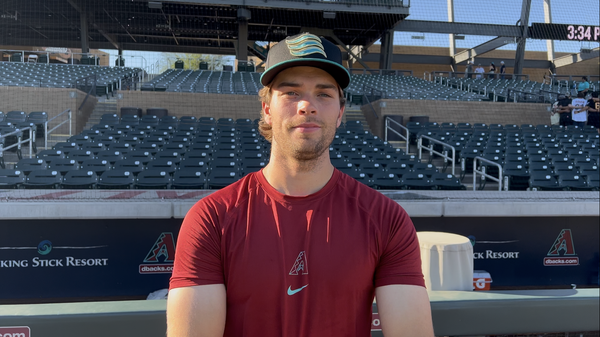Is Brandon Pfaadt's Cutter the Key to Unlocking His Entire Arsenal?
With the addition of the cutter, Brandon Pfaadt has more room to attack both right-handed and left-handed hitters alike in all four directions.
Brandon Pfaadt turned in the best start of his career in Wednesday’s 8-2 win. The story from that game was the usage of his cutter, throwing 18 in total and 17 against left-handed hitters. It’s a fairly new pitch in his arsenal, but we saw the effects of what good cutter usage could do in that start.
The key to a good cutter is a pitch that looks and spins like a four-seam fastball out of the hand to the hitter’s eye. Ideally, it carries to home plate for as long as possible, past the point where they have to commit, until it takes a sharp and late break to miss barrels and swings. It’s a very effective pitch to tunnel with a four-seamer, and why so many elite starting pitchers use it.
D-backs Under Review is a reader-supported publication. To receive new posts and support my work, consider becoming a free or paid subscriber.
How the Cutter Rounds Out Pfaadt’s Arsenal
Looking at Pfaadt’s arsenal, it makes sense to add a cutter to round out his arsenal. His best pitch in terms of Stuff+ is his mid-80s sweeper. It clocks in at 115, pushing “plus” territory when factoring velocity, shape, and release data.
Building his arsenal around his one plus-quality offering, Pfaadt has incorporated a sinker, changeup, curveball, and a four-seamer to his arsenal. Only the curveball has a Stuff+ rating higher than 100. So that means he’s more reliant on command, sequencing, and tunneling to get hitters out.
The sinker and sweeper typically tunnel well off each other, but are very platoon-heavy pitches that match up better against same-handed (right-handed) hitters. As a starting pitcher, teams are going to load their lineup with as many left-handed bats. Pfaadt can utilize the sweeper, but the margin for error is small, and his execution is not consistent enough to make it work without risking barreled contact.
Knowing that, he has to have pitches that can neutralize left-handed hitters. That means elevating the four-seamer, with purpose, while using the curveball and changeup as out pitches. However, the two secondary pitches have not fared well. The curveball is yielding a .394 average and .818 slugging% while the changeup clocks in at .280 and .440.
Adding the cutter gives Pfaadt a pitch that he can throw that moves in on left-handed hitters with considerably less risk of catching barrels. The pitch has gotten early success, holding lefties to a .167 average and .250 slugging%.
The introduction of the cutter now allows Pfaadt to move the ball in all four directions in the zone (cutters/sweepers glove side, four-seamers up, sinker/changeups arm side, curveballs down) and induce chases to both righties and lefties alike.
“He’s still young, he’s still learning his arsenal, learning what works the best at this level for him,” Diamondbacks catcher James McCann told Jody Jackson after the game on the DbacksTV broadcast.
How Pfaadt Learned His Cutter
After the game, Pfaadt talked to the media about his new cutter.
"I know Eddie [Rodríguez] throws a cutter, [Zac] Gallen and Merrill [Kelly] throw a cutter, and [Ryne Nelson] throws a cutter,” Pfaadt told Alex Weiner of Arizona Sports. “So I guess I was the only one that didn't throw a cutter, so I had to bring it out."
Statcast has classified 46 of his pitches this season as cutters. It has a spin axis of 12:00, but deviates to an 11:15 movement profile (6.6” induced vertical break, 1.9” glove-side break). That’s the same as Gallen’s, although his gets more total movement due to a higher active spin rate (49% vs. 33%). It’s possible he learned the cues from him, but it’s unclear if Pfaadt mentioned as such.
Fun Little Anecdote
Back in March 2023, while waiting for the Corbin Carroll extension press conference, I joked with Jesse Friedman that Pfaadt should learn a cutter to counteract the fact that he had a low spin efficiency on his four-seamer. My understanding came down to this Foolish Baseball video about future Diamondback Corbin Burnes.
At the time, I had extremely limited knowledge of pitch shaping, tunneling, and other factors that make pitchers great. I still wouldn’t claim it’s very strong compared to the likes of Lance Brozdowski, Eno Sarris, and others who specialize in this field. Of course now, with two more years of experience and reading the work of others smarter than me, the realization is that there is no “one size fits all” approach.
D-backs Under Review is a reader-supported publication. To receive new posts and support my work, consider becoming a free or paid subscriber.
D-backs Under Review is Michael McDermott’s publication for deep analysis dives, game coverage, prospect coverage, and breaking down the biggest news topics involving the Arizona Diamondbacks. Michael has been writing about the D-backs since the 2015 season, with stops at AZ Snake Pit, Diamondbacks On SI, Venom Strikes, and Burn City Sports. He has covered over 40 MLB games at Chase Field and the Arizona Fall League.



